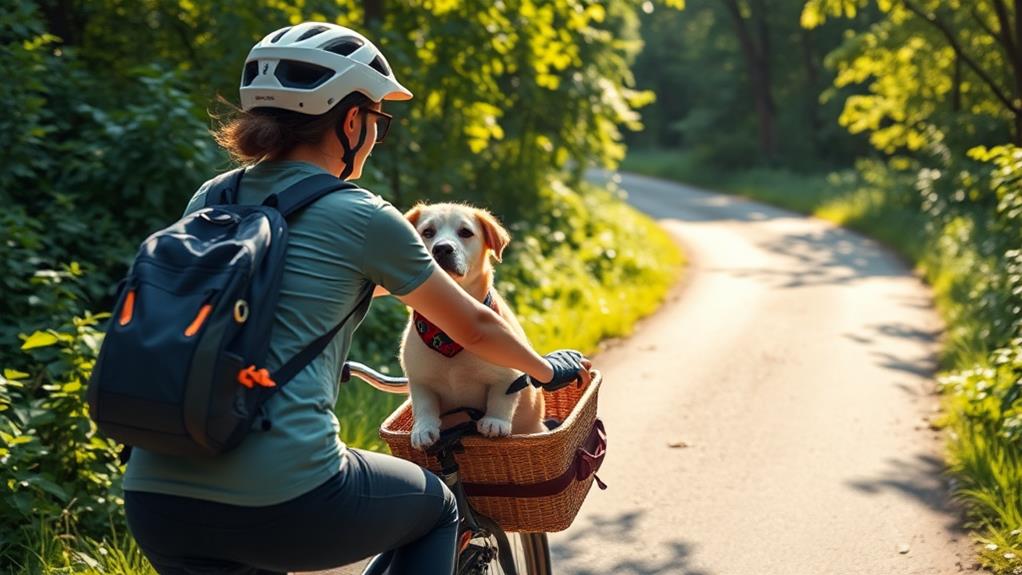Cycling with your dog can be a fantastic experience, but keeping safety in mind is key. Start by choosing the right equipment, including a sturdy bike and a well-fitted harness for your dog. Assess your dog's fitness level and train them gradually, using positive reinforcement and teaching important commands. Use a 4-6 feet leash for better control, and always stay aware of your surroundings. Don't forget to schedule breaks for hydration and watch the weather closely to avoid overheating or accidents. For more detailed tips on ensuring a safe and enjoyable ride, stick around to discover practical advice.
Choose the Right Equipment
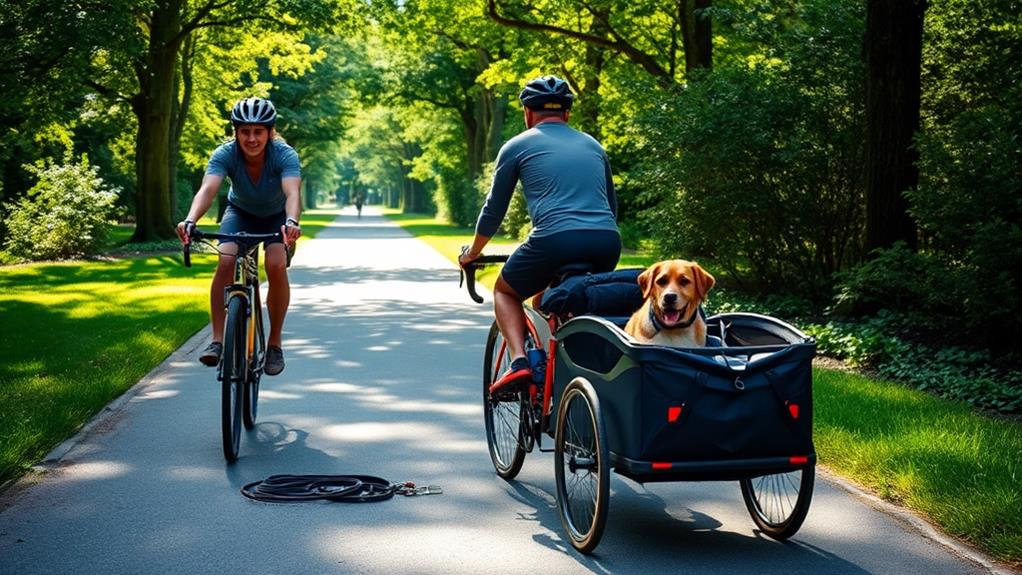
Choosing the right equipment is essential for a safe and enjoyable ride with your dog. Start with a sturdy bicycle that suits your riding style and terrain. If you plan on biking longer distances or on rough paths, investing in a mountain bike or hybrid model will give you better control and stability.
Next, consider a reliable dog carrier or bike attachment. Options like a dog trailer or a bike-mounted basket can keep your furry friend secure while you ride. Make sure your dog can comfortably fit in the chosen carrier, and always check the weight limit.
Don't forget about safety gear for both you and your dog. A well-fitted dog harness is pivotal, as it'll prevent neck strain and give you better control. Consider adding a reflective vest for your dog, especially if you're biking in low-light conditions.
Lastly, equip your bike with the necessary safety features like lights and a bell. This'll help you navigate safely and alert pedestrians. With the right equipment, you and your dog can enjoy countless adventures together while ensuring safety on the road.
Assess Your Dog's Fitness
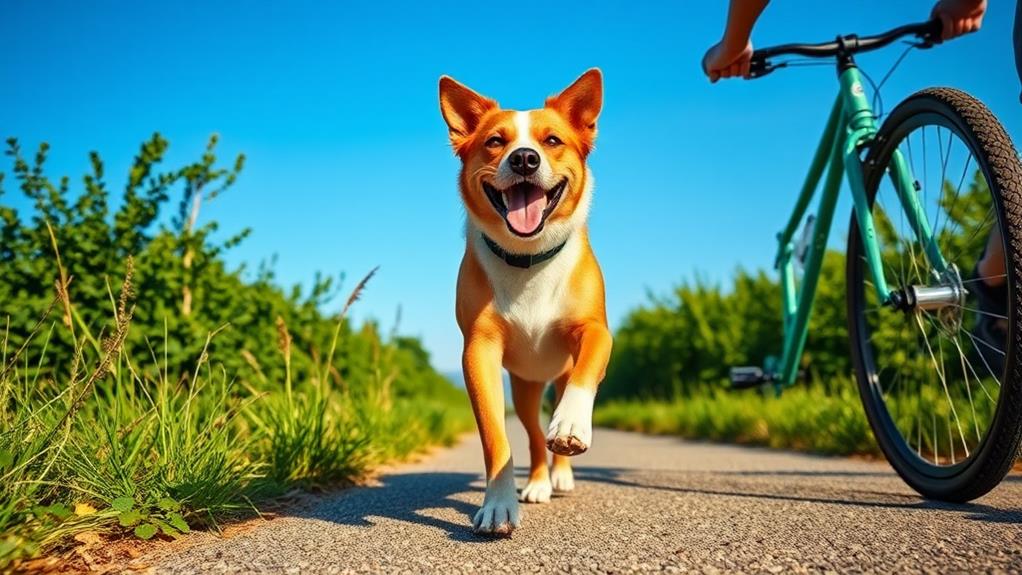
Once you've got the right equipment, it's important to assess your dog's fitness level before hitting the road. Just like people, dogs have varying levels of endurance and strength, so you want to verify your furry friend is ready for the ride.
- Age: Puppies and older dogs may not handle long rides as well as those in their prime. Contemplate your dog's age when planning your cycling distance.
- Health: Consult your veterinarian to rule out any health issues that could affect your dog's ability to keep up. Conditions like arthritis or heart problems can be limiting.
- Activity Level: Observe how active your dog is on a daily basis. If they're used to regular exercise, they're likely more prepared for cycling.
- Weight: Guarantee your dog is at a healthy weight. Overweight dogs can struggle with endurance, so make adjustments to their diet or exercise routine if necessary.
Train for Safe Riding
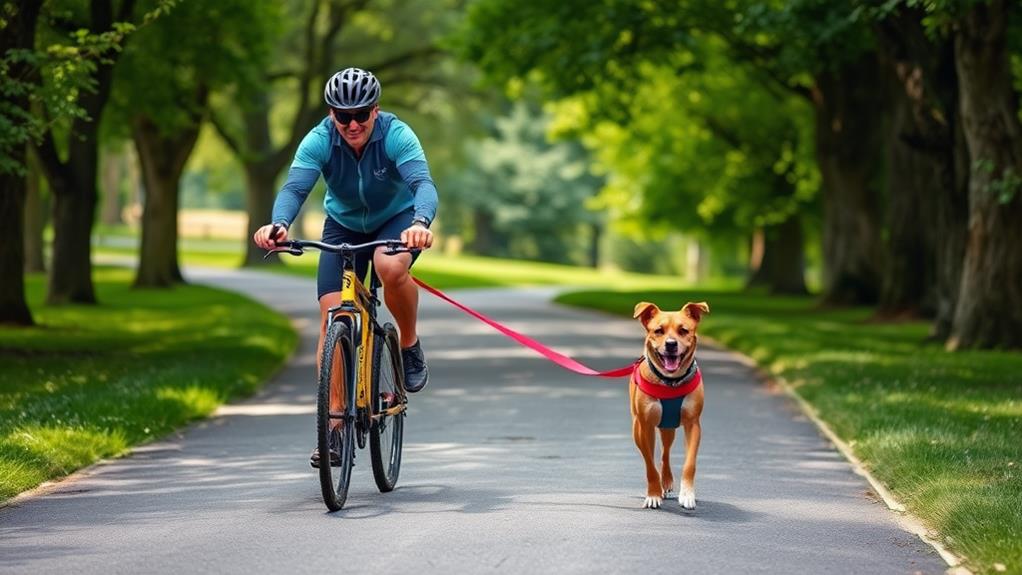
How can you guarantee both you and your dog have a safe and enjoyable ride? Start by training your dog to adjust to the bike and the riding environment. Begin with short, leisurely rides in a quiet area. Let your dog get comfortable with the sounds and sights of cycling. Gradually increase the distance as your dog becomes more accustomed to the experience.
Use positive reinforcement to encourage good behavior. Reward your pup with treats and praise when they stay close and maintain a steady pace. It's indispensable to teach your dog commands like "slow down," "stop," and "heel" during training sessions. These commands can help manage their behavior while riding.
Practice riding at different speeds and on various terrains. This helps your dog learn how to navigate bumps, turns, and sudden stops. If your dog shows signs of fatigue, like lagging behind or panting excessively, it's pivotal to take a break. Always listen to your dog's needs to ascertain their comfort and safety.
Use Proper Leash Techniques

Using the right leash approaches is essential for a safe biking experience with your dog. A proper leash not only keeps your dog secure but also allows for a smoother ride.
Some key techniques to ponder:
- Use a Short Leash: Opt for a leash that's around 4 to 6 feet long. This gives you better control and keeps your dog close to you.
- Choose a Non-Elastic Leash: Avoid stretchy leashes as they can create sudden jolts that may startle your dog or throw you off balance.
- Attach the Leash to a Harness: Use a harness instead of a collar. This reduces strain on your dog's neck and prevents injury if they pull.
- Keep Your Dog on the Side: Always position your dog on the opposite side of the bike chain. This minimizes the risk of accidents and keeps your dog away from moving parts.
Stay Aware of Surroundings
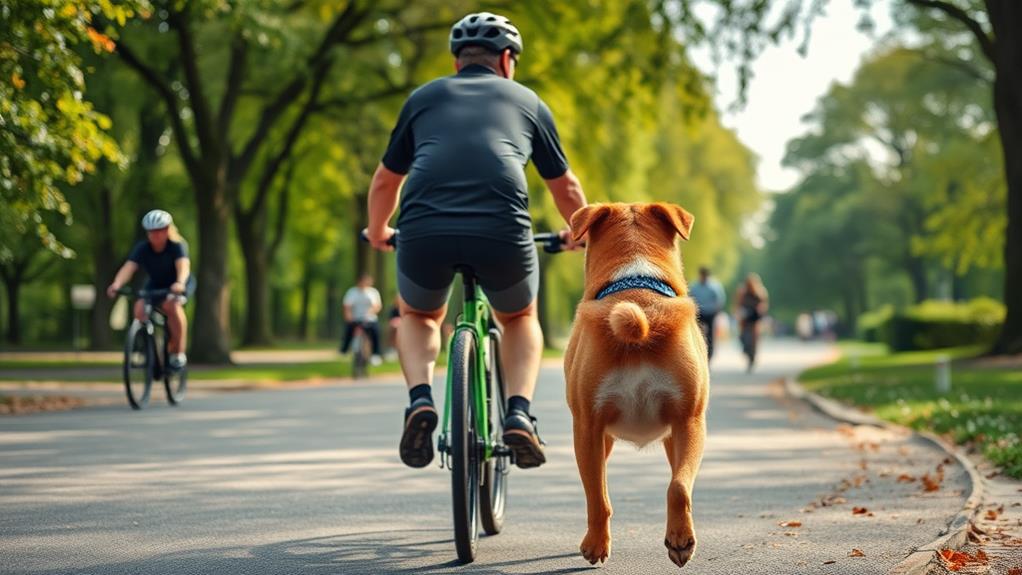
Staying aware of your surroundings is essential when biking with your dog. You need to keep an eye out for various potential hazards, including pedestrians, cyclists, and vehicles. Always be alert to what's ahead and behind you, as sudden movements from other road users could startle your dog or create an unsafe situation.
Pay attention to the environment around you. Look out for uneven surfaces, potholes, or obstacles like branches and rocks that could cause you or your dog to trip or fall. If you're riding in a park or rural area, watch for wildlife that might dart across your path.
Listen for sounds that indicate a change in your surroundings, like a barking dog or a honking horn. These cues can help you react quickly. It's also a good idea to communicate with your dog, using verbal commands to keep them informed of your movements.
Hydration and Breaks

When you're out cycling with your dog, keeping them hydrated is just as important as ensuring your own hydration. Dogs can easily overheat, especially when they're active, so it's imperative to take regular breaks and offer water.
Plan Frequent Stops: Schedule breaks every 20-30 minutes, depending on the heat and intensity of your ride. Use these breaks to give your dog water and let them rest.
Bring Water: Always carry a portable water bowl and sufficient water for both you and your dog. Consider using a collapsible bowl for convenience.
Watch for Signs of Thirst: Keep an eye out for signs that your dog needs a drink, like panting heavily or slowing down. Don't wait for them to show signs of distress.
Choose Shady Spots: When taking breaks, find shaded areas where your dog can cool off. This helps regulate their body temperature while they hydrate.
Know the Weather Conditions

Weather can greatly influence your cycling experience with your dog, so it's crucial to know the conditions before heading out. Always check the forecast to guarantee you're prepared for any unexpected changes. If it's sunny, remember that both you and your dog can easily overheat. Look for cooler times of the day, like early mornings or late evenings, and bring plenty of water for both of you.
On the flip side, if it's raining or windy, consider postponing your ride. Wet roads can be slippery, increasing the risk of accidents, and strong winds can make it difficult to control your bike. Also, be mindful of storms; lightning can pose serious dangers, so avoid cycling during severe weather.
If it's cold outside, dress your dog appropriately, especially if they've a short coat. You might also need to wear layers to stay warm. Snow and ice can also create hazards, so use caution when riding in winter conditions.
Frequently Asked Questions
What Breeds Are Best Suited for Cycling With Their Owners?
When considering breeds for cycling, you'll want active dogs like Labrador Retrievers, Border Collies, and Siberian Huskies. These breeds have high energy levels and stamina, making them perfect companions for your cycling adventures.
How Can I Calm an Anxious Dog During Bike Rides?
To calm your anxious dog during bike rides, try using a calming vest, bringing familiar toys, or stopping frequently for breaks. Positive reinforcement and gradual exposure to biking can also help ease their anxiety over time.
Are There Specific Trails Dog-Friendly for Cycling?
You can find dog-friendly trails by checking local parks or outdoor websites. Many trails welcome dogs, but make sure to verify leash policies and trail conditions before heading out to guarantee a safe, enjoyable ride.
How Do I Introduce My Dog to Cycling Gradually?
To introduce your dog to cycling gradually, start with short rides. Allow them to walk beside you, then slowly increase the distance. Reward them with treats and praise, ensuring they remain comfortable and confident throughout.
Can I Bike With My Dog in Warm Weather Safely?
Did you know that dogs can overheat in just 15 minutes on hot days? To bike safely with your dog, keep hydration handy, avoid peak heat hours, and watch for signs of fatigue or heatstroke.
Conclusion
As you gear up for your next cycling adventure with your dog, remember that safety is key. Each ride holds its own surprises, and being prepared can make all the difference. You never know when a sudden distraction or unexpected weather shift might challenge your plans. By following these tips, you'll not only enjoy the journey but also guarantee your furry companion stays safe and happy. So, are you ready to hit the road together?

